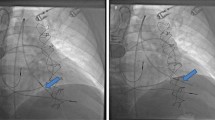Abstract
We studied the effect of correction of anemia with erythropoietin on left ventricular systolic and diastolic function at rest and exercise in 17 chronic hemodialysis patients by means of maximum exercise testing and equilibrium gated radionuclide angiocardiography on three occassions: 1) initial–before erythropoietin administration, 2) intermediate–at the time when the target hemoglobin level reached 100 g/l, and 3) long-term–after 12 months of therapy. After correction of anemia, the patients showed a significant improvement in their response to exercise regarding maximal work load achieved, exercise duration and recovery time. Ejection fraction and peak ejection rate remained unchanged during therapy. At rest, peak filling rate was reduced from 2.62 ± 1.0 (baseline) to 2.28 ± 0.9 (intermediate) end-diastolic volume per second, p < 0.01, while no significant difference was observed during exercise. The time to peak filling rate was prolonged significantly during EPO therapy from 157 ± 30 to 177 ± 28 ms at rest, p < 0.05, and from 101 ± 24 to 130 ± 27 ms during exercise, p < 0.01. By the time of the late study, there were no significant differences between the late and intermediate study. In conclusion, amelioration of anemia with erythropoietin in hemodialysis patients produced improvement in exercise capacity, but diastolic function worsened with therapy and this effect was maintained during the long-term treatment, while systolic function at rest and exercise remained unchanged.
Similar content being viewed by others
References
Eschbach JW, Abdulhadi MH, Browne JK, Delano BG, Downing MR, Egrie JC, Evans RW, Friedman EA, Graber SE, Haley NR, Korbet S, Krantz SB, Lundin AP, Nissenson AR, Ogden DA, Paganini EP, Rader B, Rutsky EA, Stivelman J, Stone WJ, Teschan P, VanStone JC, VanWyck DB, Zuckerman K, Adamson JW. Recombinant human erythropoietin in anemic patients with end-stage renal disease. Results of phase III multicenter clinical trial. Ann Intern Med 1989; 111: 992-1000.
Mayer G, Horl WH. Cardiovascular effects of increasing hemoglobin in chronic renal failure. Am J Nephrol 1996; 16: 263-267.
Pavel DG, Zimmer AM, Patterson VN. In vivo labeling of red blood cells with Tc-99m: a new approach to blood pool visualization. J Nucl Med 1977; 18: 305-308.
Bonow RO, Rosing DR, Bacharach SL, Green MV, Kent KM, Lipson LC, Maron BJ, Leon MB, Epstein SE. Effects of verapamil on left ventricular systolic function and diastolic filling in patients with hypertrophic cardiomyopathy. Circulation 1981; 64: 787-796.
Macdougall IC, Lewis NP, Saunders MJ, Cochlin DL, Davies ME, Hutton RD, Fox KAA, Coles GA, Williams JD. Long-term cardiorespiratory effects of amelioration of renal anaemia by erythropoietin. Lancet 1990; 335: 489-493.
Metra M, Cannella G, La Canna G, Guaini T, Sandrini M, Gaggiotti M, Movilli E, Dei Cas L. Improvement in exercise capacity after correction of anemia in patients with end-stage renal failure. Am J Cardiol 1991; 68: 1060-1066.
Martin GR, Ongkingo JR, Turner ME, Skurow ES, Ruley EJ. Recombinant erythropoietin (Epogen) improves cardiac exercise performance in children with end-stage renal disease. Pediatr Nephrol 1993; 7: 276-280.
Fellner SK, Lang RM, Neumann A, Korcarz C, Borow KM. Cardiovascular consequences of correction of the anemia of renal failure with erythropoietin. Kidney Int 1993; 44: 1309-1315.
Juric M, Rupcic V, Topuzovic N, Jakic M, Brlosic R, Rusic A, Karner I, Stipanic S, Kes P. Haemodynamic changes and exercise tolerance in dialysis patients treated with erythropoietin. Nephrol Dial Transplant 1995; 10: 1398-1404.
Facchin L, Vescovo G, Levedianos G, Zannini L, Nordio M, Lorenzi S, Caturelli G, Ambrosio GB. Left ventricular morphology and diastolic function in uraemia: echocardiographic evidence of a specific cardiomyopathy. Br Heart J 1995; 74: 174-179.
Goldsmith SR, Dick C. Differentiating systolic from diastolic heart failure: pathophysiologic and therapeutic considerations. Am J Med 1993; 95: 645-655.
Harnett JD, Parfey PS. Cardiac disease in uremia. Semin Nephrol 1994; 14: 245-252.
Fujimoto S, Kagoshima T, Hashimoto T, Nakajima T, Hohi K. Left ventricular diastolic function in patients on maintenance hemodialysis: comparison with hypertensive heart disease and hypertrophic cardiomyopathy. Clin Nephrol 1994; 42: 109-116.
Horl WH, Riegel W. Cardiac depressant factors in renal disease. Circulation 1993; 87(suppl 5): IV77-82.
Geskin G, Schulman DS. Relation of changes in left ventricular peak filling rate during exercise to exercise performance in systemic hypertension and in healed myocardial infarction. Am J Cardiol 1997; 80: 1144-1149.
Author information
Authors and Affiliations
Rights and permissions
About this article
Cite this article
Topuzović, N. Worsening of left ventricular diastolic function during long-term correction of anemia with erythropoietin in chronic hemodialysis patients – an assessment by radionuclide ventriculography at rest and exercise. Int J Cardiovasc Imaging 15, 233–239 (1999). https://doi.org/10.1023/A:1006171626861
Issue Date:
DOI: https://doi.org/10.1023/A:1006171626861




